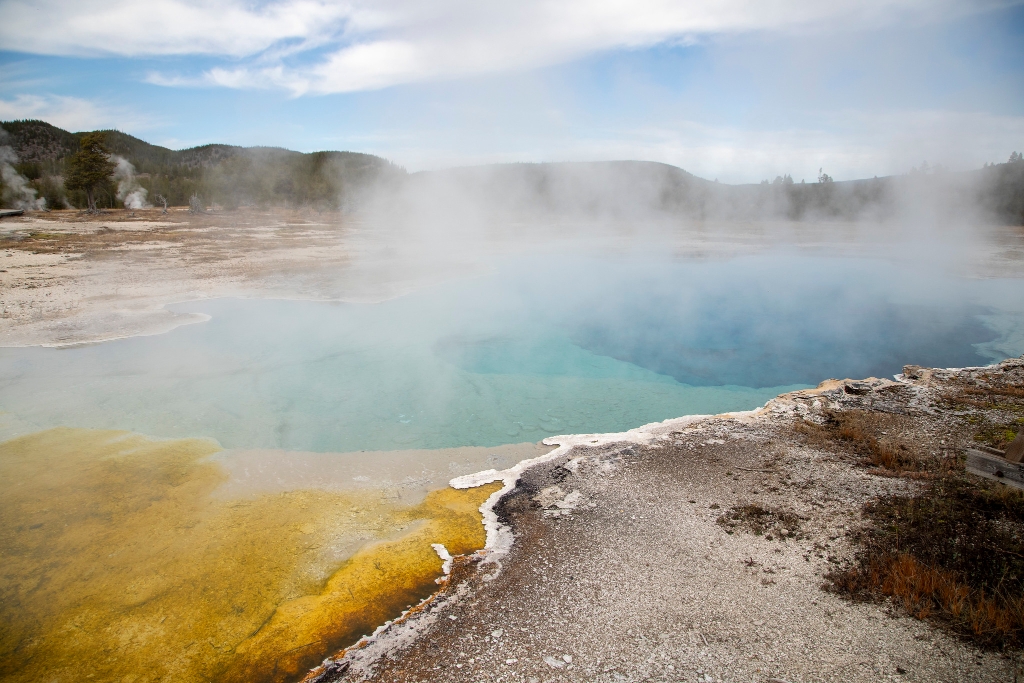
Named for the unusual biscuit-like deposits that used to surround Sapphire Pool.
Following the 1959 Hebgen Lake earthquake, Sapphire Pool erupted, and the “biscuits” were blown away. It last erupted in 1991. Sapphire remains one of the most beautiful blue pools in the park. Mustard Spring provides a bright color contrast, and Jewel Geyser erupts every 7-10 minutes.
The following trails can be accessed from this trailhead:
- Biscuit Basin Trail
- Mystic Falls Trail
- Summit Lake Trail
Biscuit Basin Trail
Biscuit Basin is traversed by an easy 0.6-mile (1-km) lollipop loop boardwalk trail, which leads past many fascinating hydrothermal features, such as Sapphire Pool, Avoca Spring, and Jewel Geyser.
Mystic Falls Trail
This 2.4-mile (3.8-km) there-and-back trail follows a lovely creek through mixed conifer forest to the 70-foot Mystic Falls, over which the Little Firehole River drops from the Madison Plateau.
Summit Lake Trail
This moderately strenuous 14.5-mile (23.3-km) one-way trail starts a little ways down the Mystic Falls Trail, which starts at the west end of Biscuit Basin. The trail, which is part of the Continental Divide Trail, ascends the hillsides overlooking the Upper Geyser Basin and the Firehole River. Both Summit Lake and the Smoke Jumper Hot Springs Thermal Area are about midway along the trail.
Upper Geyser Basin
The majority of world’s active geysers are in the Upper Geyser Basin, including Old Faithful. Only four other places in the world have large concentrations of hydrothermal features: Russia (Kamchatka), Chile, New Zealand, and Iceland.
The heat for the hydrothermal features comes from Yellowstone’s volcano. Molten rock or magma may be as close as 3-8 miles (5-13 km) underground. Rain and snow supply water that seeps downs several thousand feet (more than a kilometer) below the surface where it is heated.
Underground cracks form a natural plumbing system. Hot water rises through the plumbing to produce hot springs and geysers.
Hot Springs
Hot springs are the most common hydrothermal features in Yellowstone. Their plumbing has no constrictions.
Superheated water cools as it reaches the surface, sinks, and is replaced by hotter water from below.
This circulation prevents water from reaching the temperature needed to set off an eruption.
Color and Heat Lovers
Hydrothermal features are also habitats in which microscopic organisms survive and thrive. They are called thermophiles: "thermo" for heat and "phile" for lover.
Although they are too small to be seen with the naked eye, trillions are grouped together and appear as masses of color. They are nourished by energy and chemical building blocks.
Colorless and yellow thermophiles grow in the hottest water.
Orange, brown, and green thermophiles grow in cooler waters.
Imagine living in near-boiling temperatures, in hydrothermal features with the alkalinity of baking soda, or in water so acidic that it can burn holes in clothing. Microorganisms in Yellowstone need these extremes to survive.
Geysers
Geysers have constrictions in their plumbing systems that prevent water from moving freely to the surface where heat would escape. Water beneath the constrictions creates a buildup of steam. Eventually the steam pushes water past the constrictions and the geyser erupts.
Accessibility
Trail has a wheelchair-accessible overlook at Wall Pool.
Use Caution in Hydrothermal Areas
- Stay on boardwalks and designated trails.
- Hydrothermal water can severely burn you.
- Never run, push, or shove.
- Supervise children at all times.
- Do not scratch hydrothermal mats.
You are responsible for your safety.
Think safety, act safely. Yellowstone is a dangerous place.
Is there something we missed for this itinerary?
Itineraries across USA


















































